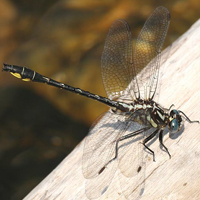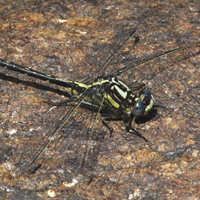Rapids Clubtail
Scientific name: Phanogomphus quadricolor


Photo credits: Glenn Corbiere
Status
Threatened
“Threatened” means the species lives in the wild in Ontario, is not endangered, but is likely to become endangered if steps are not taken to address factors threatening it.
Date added to the Species at Risk in Ontario List
September 10, 2009
Read the most recent assessment report (PDF).
What it looks like
The Rapids Clubtail is a relatively small (42 to 45 millimetre-long), brightly coloured dragonfly. Its eyes are bluish-green, with a light yellowish-green face that is striped with two dark lines, a brownish-black and yellowish-green striped body, and transparent wings.
Like all dragonflies, the Rapids Clubtail begins its life as an aquatic larva and transforms into a winged adult during the summer.
Where it lives
The Rapids Clubtail is typically found in clear, cool medium-to-large rivers with gravel shallows and muddy pools. Larvae occupy quiet muddy pools. Adult males perch on exposed rocks and other projections in the rapids. Males are quite territorial and make short flights over the water, repeatedly returning to the same perch.
Adult females typically inhabit forests along riverbanks, and only visit shallows and pools when they are ready to mate and lay eggs.
The Rapids Clubtail is a globally rare to uncommon species found throughout eastern North America. Within this range the species and its habitat are locally distributed and there are large areas where the species does not occur.
Most populations of the Rapids Clubtail are located in the U.S. Midwest, but their range extends from northern Alabama and Georgia to southern Ontario, and from Maine to eastern Minnesota.
Where it’s been found in Ontario
In Ontario, the Rapids Clubtail has only been found in seven rivers in southern and eastern Ontario: the Thames, Humber, Credit and Mississippi.
- Ausable River
- Thames River
- Nith River
- Grand River
- Humber River
- Credit River
- Mississippi River
What threatens it
The primary threat to the Rapids Clubtail is the degradation of river habitats. Activities which impede or alter the quantity and quality of water in the rivers it inhabits, such as dams and pollution, pose threats.
Such degradation has led to the apparent demise of this species on the Credit River and the decline of the population on the Humber River.
Action we are taking
This species and its habitat are protected under Ontario’s Endangered Species Act, 2007 (ESA).
The ESA also requires us to prepare recovery guidance for threatened species such as Rapids Clubtail to guide recovery efforts for the species in Ontario.
All species listed on the Species at Risk in Ontario List may be eligible for consideration for government funding through the Species at Risk Stewardship Program.
Recovery strategy
A recovery strategy advises the ministry on ways to ensure healthy numbers of the species return to Ontario.
Read the executive summary (September 10, 2010)
Read the recovery strategy (September 10, 2010)
Government response statement
A government response statement outlines the actions the government intends to take or support to help recover the species.
Read the government response statement (June 15, 2011)
Five-year review of progress
A five-year review reports on progress made toward protecting and recovering a species, within five years of publishing a species’ government response statement.
Read the report on progress towards the protection and recovery of 27 species at risk, including Rapids Clubtail (2016).
Habitat protection
A habitat regulation defines a species' habitat and may describe features (such as, a creek, cliff, or beach), geographic boundaries or other unique characteristics.
Read the habitat summary (July 1, 2012).
Read the regulation (July 1, 2012).
What you can do
Report a sighting
Submit your observations of species at risk to the Natural Heritage Information Centre (NHIC), which is Ontario’s conservation data centre. Join the centre’s Rare Species of Ontario project in iNaturalist, an online plant and animal identification app, to quickly and easily submit your observations.
Volunteer
Volunteer with your local nature club or provincial park to participate in surveys or stewardship work focused on species at risk.
Be a good steward
- Private landowners have a very important role to play in species recovery. If you find species at risk on your land, you may be eligible for stewardship programs that support the protection and recovery of species at risk and their habitats, such as the Species at Risk Stewardship Program.
- Soil erosion and runoff is a source of pollutants (like fertilizers and pesticides) that enter watercourses in Ontario. There are many things that you can do to help reduce these effects, and you may be eligible for funding assistance. You can find more information about programs and funding assistance from organizations such as the Ontario Soil and Crop Improvement Association and ALUS Canada.
- Invasive species seriously threaten many of Ontario’s species at risk. To learn what you can do to help reduce the threat of invasive species, visit:
- Don’t disturb or harass wildlife; be respectful and observe from a distance.
Report illegal activity
Report any illegal activity related to plants and wildlife to
Quick facts
- Adult Rapids Clubtails only live for three to four weeks. They are active between early June and mid-July.
- Larvae bury themselves under a fine layer of sediment and ‘breathe’ through the exposed tip of their abdomen.